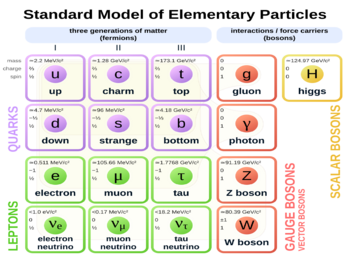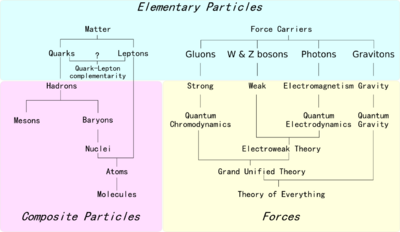Fundamental interaction facts for kids
There are four fundamental forces, sometimes called fundamental interactions. These forces are the most basic ways that objects in the universe affect each other. They are called fundamental because scientists haven't found a simpler way to explain how they work. They are called interactions because when one object acts on another, the second object also reacts back.
We feel the effects of gravity and electromagnetism all the time in our daily lives.
- The gravitational force is what pulls things down to Earth. It's also what keeps planets orbiting the Sun. Albert Einstein explained gravity as the curvature or bending of spacetime by objects that have mass.
- The electromagnetic force is caused by electric charge. This force creates both electric effects (like static electricity) and magnetic effects (like magnets). It's also responsible for light and for holding atoms and molecules together.
The strong and weak interactions are forces that act over very tiny distances, mostly inside atoms. They help explain how atomic nuclei behave.
- The strong force is the most powerful force. It binds protons and neutrons together inside the nucleus of an atom. Without it, the positively charged protons would push each other apart.
- The weak force causes a type of radioactive decay called beta decay. This process changes one type of particle into another.
A full understanding of these forces involves advanced physics. The Standard Model is a theory that explains three of these forces: electromagnetism, the weak force, and the strong force. Most physicists believe that these three forces might have been a single force at extremely high temperatures, like those found just after the Big Bang. This idea is part of the grand unification theory.
Contents
How Scientists Understood Forces
Early Ideas About Forces
In 1687, Isaac Newton described gravity with his law of universal gravitation. He thought that all objects with mass instantly pulled on each other, no matter how far apart they were. This was called "action at a distance" because there was no clear way for the force to travel between objects.
Later, in the 1820s, Michael Faraday studied magnetism. He suggested that a "field" filled space and carried the magnetic force. Faraday even thought that all forces might eventually be unified into one.
In 1873, James Clerk Maxwell combined the ideas of electricity and magnetism. He showed that they were two parts of one electromagnetic field. He also discovered that light was an electromagnetic wave that traveled at a constant speed. This was a big step in understanding forces.
The Standard Model of Particles

The Standard Model of particle physics was developed in the second half of the 20th century. It explains how the electromagnetic, strong, and weak forces work at the smallest scales. In this model, these forces are linked to tiny elementary particles.
The Standard Model says that matter is made of particles called fermions. These include quarks (which make up protons and neutrons) and electrons. Forces happen when these matter particles exchange other particles called gauge bosons. These bosons are like "force carriers" or "messenger particles."
For example:
- The electromagnetic force is carried by photons. When electrons interact, they exchange photons. This is how atoms form molecules and how light travels.
- The weak force is carried by heavy W and Z bosons. This force is important for nuclear reactions in the Sun.
- The strong force is carried by gluons. Gluons hold quarks together inside protons and neutrons. They also keep the atomic nucleus from falling apart.
Scientists also discovered the Higgs boson. This particle is linked to the Higgs mechanism, which helps explain why some particles have mass.
The Standard Model is the most successful theory in physics, with many experiments proving its predictions. However, it doesn't include gravity. Scientists are still working on theories that could combine all four fundamental forces into one "Theory of Everything" (ToE).
Understanding the Fundamental Interactions
In the world of tiny particles, matter is made of fermions. These particles have properties like charge and spin. They attract or push each other away by exchanging bosons.
Think of it like this:
- Two matter particles come close.
- They interact by exchanging a force-carrying boson.
- The two matter particles change their speed, direction, or even their type.
When bosons are exchanged, they carry energy and momentum between the matter particles. This changes how the particles move. Sometimes, a boson can even transfer a charge, changing one type of particle into another. These interactions are what create the forces we feel in the everyday world.
Here is a simple overview of the four fundamental interactions:
| Interaction | Current Theory | Force Carriers | Relative Strength | Range (how far it acts) |
|---|---|---|---|---|
| Weak | Electroweak theory | W and Z bosons | 1033 | Very short (10−18 meters) |
| Strong | Quantum chromodynamics | gluons | 1038 | Very short (10−15 meters) |
| Gravitation | General relativity | gravitons (hypothetical) | 1 | Infinite |
| Electromagnetic | Quantum electrodynamics | photons | 1036 | Infinite |
In modern quantum mechanics, particles of matter (fermions) don't directly touch each other to interact. Instead, they have a "charge" and exchange virtual particles (gauge bosons). These virtual particles are the ones that carry the force. For example, photons carry the electromagnetic force between electric charges, and gluons carry the strong force between "color charges" inside quarks.
|
See also
 In Spanish: Interacciones fundamentales para niños
In Spanish: Interacciones fundamentales para niños


